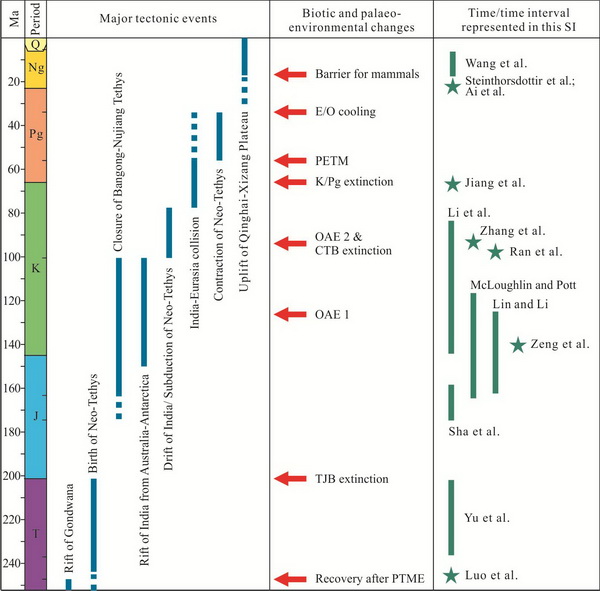Recently, the famous international geological journal Palaeogeography, Palaeoclimatology, Palaeoecology (commonly referred to as "Palaeo 3") published a new special issue on the topic of Mesozoic and Cenozoic evolution of eastern Tethys co-edited by Prof Li Jianguo and Prof. Sha Jingeng in the Nanjing Institute of Geology and Palaeontology, Chinese Academy of Sciences, and their international cooperation team (volume 515, 2019).
Since the 1960s when the theory of plate tectonics became established, the Tethys region has attracted the attention of many geologists because it has experienced a complex evolution involving numerous continental fragments drifting in several stages from the Gondwanan margin in the Southern Hemisphere northward to amalgamate with Eurasia in the Northern Hemisphere. This process and the subsequent orogenies caused great changes to the regional or even global topography and environments, which researchers now realize had important impact on climate and biotas.
The vast literature on the evolution of the Tethys Ocean highlights several critical scientific issues that require further investigation. These include especially: (1) what was the extent of the Tethys and its surrounding landmasses at the time that Pangea began to break up?; (2) when and how did the Cimmeride terranes rift from Gondwana and collide with proto-Eurasia?; (3) what was the motion history of the Indian plate during its northward journey, and when and where did it collide with Eurasia?; (4) when did the Neo-Tethys come into being and subsequently close up?; (5) what was the driving force behind continental fragmentation that gave rise to the Neo-Tethys?; (6) what processes were involved in the uplift of the Qinghai-Xizang Plateau, and what was the chronology of uplift events?; (7) what were the impacts of these events on Earth’s climate and biotas? (Fig. 1).
The answers to each question in above are complex and require a large number of facts or data from multiple regions and disciplines. So far, the data and findings revealed and accumulated by scientists are still very scarce, restricting our progress in the study of Tethys tectonics and biological evolution.
The newly published special issue reports the latest research results of scientists from multiple countries in magmatic petrology, geochemistry, palaeontology and sedimentology from the eastern Tethys. A total of 13 research papers and one reviewing paper as preface are contained. These papers cover a multitude of issues relating to the evolution of the Tethys, such as the timing of initiation of the Neo-Tethys, the properties of the Bangong-Nujiang Tethys, the rifting process of the Indian plate, palaeoenvironmental events during Tethyan evolution, the impact on terrestrial ecosystems of closure of the Tethys and uplift of the Qinghai-Xizang Plateau. These advances provide insights into and will stimulate further research on the evolution of the eastern Tethys.
This SI is a joint product of years of collaboration and efforts by scientists from various countries and is supported by the Strategic Priority Research Program of the Chinese Academy of Sciences (XDB03010103, XDB26000000 and XDA20070202), the National Natural Science Foundation of China (41872004), and UNESCO -IUGS project IGCP 632.
Special issue information: Li, Jianguo, Sha, Jingeng, McLoughlin, Stephen, Wang, Xiaoming, eds., 2019. Palaeogeographic, palaeoclimatic and palaeoecologic evolution of eastern Tethys during the Mesozoic and Cenozoic.Palaeogeography, Palaeoclimatology, Palaeoecology515.

A summary of key events in the evolution of Tethys as studied by previous researchers and authors in this issue
Download:
